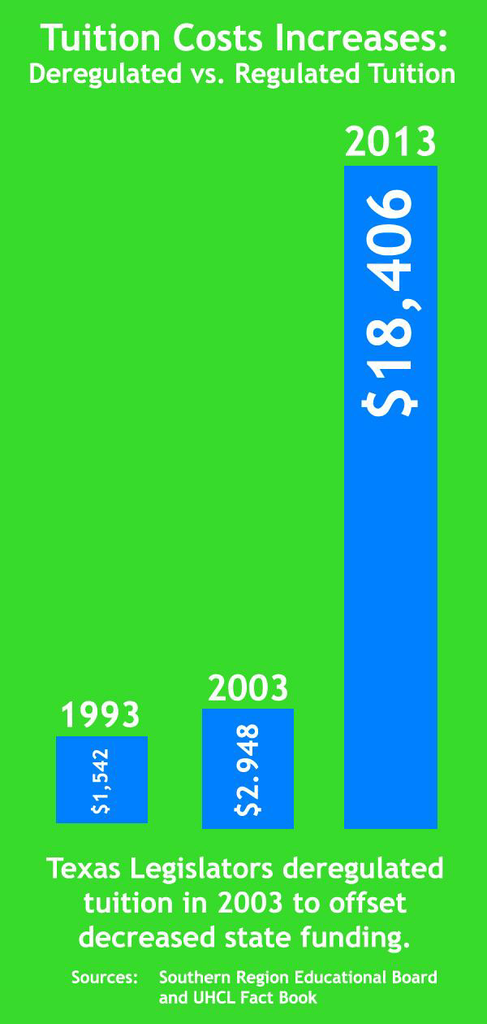Fixed-rate tuition on the horizon
Part 3 of a 3-part series on college tuition in Texas
 LOREE COUCH
LOREE COUCH
THE SIGNAL
The University of Houston System Board of Regents approved an optional four-year fixed rate plan Feb. 26 that will go into effect fall 2014.
The board approved a systemwide four-year fixed-rate tuition in the hopes of encouraging students to graduate in a timely manner. The optional rate plan will be available for all first-time college students and qualifying undergraduate transfer students who will be entering University of Houston institutions in the fall.
The plan requires students to complete at least 30 semester credit hours during an academic year.
Fixed tuition rates will not necessarily lower the overall cost of tuition; students will pay more up front to balance out the cost of four years.
“The student will pay an accelerated rate in the early years and will not see a positive financial impact until the second or third year of the plan based on his or her major,” said Michelle Dotter, vice president over finance, and Usha Mathew, associate vice president over finance, in a release statement to The Signal. “All mandatory fees/course fees will continue to be variable and may change annually in the fixed tuition rate plan.”
Students who choose not to be a part of the fixed-rate tuition plan will continue to pay an adaptable rate tuition, which is subject to increase each academic year.
Tuition revenues at the University of Houston System will be used to enhance programs and resources aimed at promoting student success. The University of Houston-Clear Lake plan is to dedicate this revenue toward the growth and retention of faculty and staff. The university also plans to add a new nursing program.
The fixed rates, also known as tuition freezes, are a part of a state government policy that restricts the ability of administrators of colleges and universities to increase tuition fees for students. The hope is that this policy will help to improve the accessibility of secondary education for working-class families and students.
The changes in tuition policy were instigated by Texas Governor Rick Perry, who, while attending the Texas Tribune Festival in September 2012, stated that students who go to state universities should retain the same tuition costs in their senior year as when they entered as freshmen.
“We’ll tell an incoming freshman, ‘This is what the university will charge you for four years,’” Perry stated at the festival.
The cost of college tuition has become increasingly more expensive for students attending state universities in Texas since it was deregulated under Perry’s administration in 2003. When state funding decreased, tuition was deregulated in order to make up for the loss in funding.
“The intent of fixed-rate tuition is to add predictability to the cost of attendance for families,” said Kelly Polden, assistant director of communications at the Texas Higher Education Coordinating Board. “Texas House Bill 29 indicates a specific tuition rate will be set for the entering student who chooses to participate in a fixed-rate program, and will apply for at least the first 12 consecutive terms after the student’s initial enrollment.”
In Texas, House Bill 29 was created to help families and students who lacked financial stability to better manage the cost of finishing their education at a university and graduating. The tuition rate will not change as long as students enrolled in this program complete their degree in four years.
Yet this same time table is what the opponents of the tuition freeze address. Those who disagree with the policy point out that many students must work in order to pay for school. While taking 15 credit hours a semester may be doable for some students, juggling a full-time job while maintaining a full-time course load can make things difficult for students who are trying to graduate.
Another issue that opponents of the tuition freezes are quick to point out is that tuition freezes have a history of a higher increase in tuition when the states that practice this policy are going through periods of low funding. When these states experience low funds and public universities are forced to raise tuition again, it is often a significantly higher increase for which the student body is generally unprepared.
Texas is the second state in the nation to offer fixed-rate tuition for students who are attending state colleges and universities. Many states have followed the example and now offer fixed-rate tuition.
“I do know that the University of Texas and other institutions have started implementing fixed-rate tuition,” Polden said.
Perry also called for linking 10 percent of universities’ state funding to the population of student graduates. While speaking about this new policy at Thomas Jefferson High School in northwest Dallas, Perry explained that if colleges and universities are not having as many students graduating, they will receive less funding.
“This will encourage universities to do everything they can to help their students complete their degrees and graduate in a timely fashion,” Perry said.

